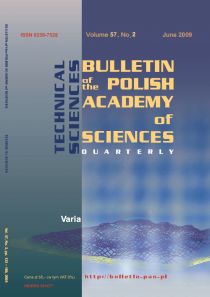POLISH ACADEMY of SCIENCES
TECHNICAL SCIENCES

Advanced materials and technologies
| BULLETIN
of the
POLISH ACADEMY of SCIENCES TECHNICAL SCIENCES |
 |
|||
|---|---|---|---|---|
| Volume
58, Issue 2, June 2010
Advanced materials and technologies |
||||
| Issue Index | Authors Index | Scope Index | Web Info | |
|
|
||||
| Aims&Scope, Subscription | Editors | Authors' guide | to read PDF files | mirror: http://fluid.ippt.gov.pl/~bulletin/ |
| pp 303 - 315 |
|---|
|
Protein conformational changes induced by adsorption onto material surfaces: an important issue for biomedical applications of material science |
|---|
| T. BALLET , L. BOULANGE , Y. BRECHET , F. BRUCKERT , and M. WEIDENHAUPT |
| Protein adsorption on solid surfaces is a widespread phenomenon of large biological and biotechnological significance. Conformational changes are likely to accompany protein adsorption, but are difficult to evidence directly. Nevertheless they have important consequences, since the partial unfolding of protein domains can expose hitherto hidden amino acids. This remodeling of the protein surface can trigger the activation of molecular complexes such as the blood coagulation cascade or the innate immune complement system. In the case of extracellular matrix, it can also change the way cells interact with the material surfaces and result in modified cell behavior. In this review, we present direct and indirect evidences that support the view that some proteins change their conformation upon adsorption. We also show that both physical and chemical methods are needed to study the extent and kinetics of protein conformational changes. In particular, AFM techniques and cryo-electron microscopy provide useful and complementary information. We then review the chemical and topological features of both proteins and material surfaces in relation with protein adsorption. Mutating key amino acids in proteins changes their stability and this is related to material-induced conformational changes, as shown for instance with insulin. In addition, combinatorial methods should provide valuable information about peptide or antibody adsorption on well-defined material surfaces. These techniques could be combined with molecular modeling methods to decipher the rules governing conformational changes associated with protein adsorption. |
| Key words: |
|
protein, conformation, unfolding, aggregation, material surface, nanostructure |
|
|
| Issue Index | Authors Index | Scope Index | Web Info |
|---|---|---|---|
|
|
|||
| Aims&Scope, Subscription | Editors | Authors' guide | to read PDF files |
| Copyright ® Bulletin of the Polish Academy of Sciences: Technical Sciences |
|---|